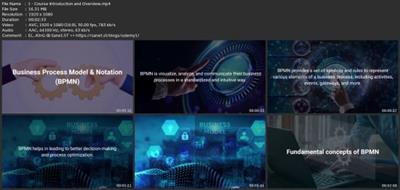
Unlocking Bpmn: Business Process Modeling And Notation
Published 10/2023
MP4 | Video: h264, 1920x1080 | Audio: AAC, 44.1 KHz
Language: English | Size: 980.85 MB | Duration: 1h 20m
BPMN Essentials: Master Business Process Modeling for Success, Enhance Process Efficiency, BPMN Techniques & Control.
What you'll learn
Gain a solid understanding of BPMN, including its concepts, terminologies, and significance in Business Process Management (BPM).
Understand the meaning and usage of BPMN symbols, including events, gateways, activities, & more, to accurately represent complex business processes.
Create clear and structured process models using various BPMN diagram types.
Delve into advanced BPMN concepts, including process data management, error handling, compensation mechanisms, event subprocesses, and looping activities.
Explore techniques for monitoring and reporting on process performance.
Learn about Analyzing and Optimizing Business Processes.
Learn about Integrating BPMN with Automation Technologies.
Learn how to track process execution, analyze data, and generate meaningful reports to evaluate process effectiveness and make data-driven decisions.
and much more
Requirements
Willingness or Interest to learn about BPMN
Description
In today's rapidly evolving business landscape, organizations across industries are seeking efficient ways to streamline their operations and achieve optimal performance. The ability to model and automate business processes is a critical skill-set for professionals looking to drive operational excellence and organizational success. This comprehensive course, "BPMN Mastery: Streamlining Business Processes through Modeling and Automation," provides participants with a deep understanding of the Business Process Model and Notation (BPMN) standard, enabling them to effectively model, analyze, optimize, and automate business processes.Course begins by laying a strong foundation, introducing participants to the key concepts, terminologies, and principles of BPMN. They will explore why BPMN is crucial in the realm of Business Process Management (BPM) and understand how it serves as a universal language for process modeling and communication across stakeholders.Participants will then dive into the core elements of BPMN, gaining a comprehensive understanding of different diagram types and their specific applications. Through hands-on exercises and practical examples, they will decipher the meanings and usage of various BPMN symbols, including events, gateways, activities, and more. This knowledge will enable participants to create clear and well-structured process models that accurately represent complex business processes.Moving on, participants will explore advanced BPMN concepts and techniques. They will learn how to effectively capture process flows, sequence activities, manage message flows, and leverage sub-processes and reusable components for process modularization and efficiency. The course will also cover essential topics such as process data management, error handling, compensation mechanisms, event sub-processes, and looping activities, equipping participants with the skills to address complex process scenarios.An integral aspect of BPMN is process analysis and optimization. Participants will discover various techniques to analyze and measure process performance, identify bottlenecks, and uncover improvement opportunities. They will explore key performance and quality metrics, learning how to interpret and utilize them to enhance process efficiency and effectiveness. Additionally, participants will gain hands-on experience with process simulation and what-if analysis, enabling them to simulate process scenarios, test alternative strategies, and make informed decisions for process optimization.As the course progresses, participants will delve into the realm of process automation. They will gain insights into the integration of BPMN with Business Process Execution Languages (BPEL), workflow engines, service orchestration, and robotic process automation (RPA). They will learn how to leverage these technologies to orchestrate, automate, and monitor business processes, driving increased efficiency, accuracy, and agility within their organizations. Participants will also explore process monitoring and reporting mechanisms, enabling them to track and evaluate process performance against defined goals and metrics.Throughout the course, participants will engage in practical exercises, case studies, and collaborative discussions, allowing them to apply their learning to real-world scenarios. They will also have access to industry best practices and expert insights, gaining a holistic view of BPMN's role in modern process management and automation.By the end of this course, participants will possess the skills and knowledge required to become proficient in BPMN, from process modeling and analysis to optimization and automation. Armed with this expertise, they will be equipped to contribute significantly to their organizations by driving process efficiency, innovation, and continuous improvement.I hope to see you in this Business Process Modeling and Notation (BPMN) journey. Let's get started.Thank you.
Overview
Section 1: Introduction to BPMN
Lecture 1 Course Introduction and Overview
Lecture 2 What is BPMN and Why is it Important?
Lecture 3 Key Concepts and Terminology in BPMN
Lecture 4 BPMN and Business Process Management (BPM)
Section 2: BPMN Fundamentals
Lecture 5 BPMN Diagram Types and Their Uses
Lecture 6 BPMN Symbols and Their Meanings
Lecture 7 Events in BPMN
Lecture 8 Gateways in BPMN
Lecture 9 Activities in BPMN
Section 3: Modeling Business Processes with BPMN
Lecture 10 Starting a BPMN Project
Lecture 11 Identifying and Documenting Process Boundaries
Lecture 12 Capturing Process Flows with BPMN
Lecture 13 Sequencing and Message Flow in BPMN
Lecture 14 Subprocesses and Reusable Process Components
Section 4: Advanced BPMN Concepts
Lecture 15 Process Data and Data Objects in BPMN
Lecture 16 Error Handling and Escalation in BPMN
Lecture 17 Compensation in BPMN
Lecture 18 Event Subprocesses and Interrupting Events
Lecture 19 Looping and Multi-Instance Activities in BPMN
Section 5: Process Analysis and Optimization
Lecture 20 Process Analysis Techniques in BPMN
Lecture 21 Identifying Bottlenecks and Improvements
Lecture 22 Performance and Quality Metrics in BPMN
Lecture 23 Process Simulation and What-If Analysis
Section 6: BPMN and Process Automation
Lecture 24 Introduction to Process Automation
Lecture 25 Integrating BPMN with Business Process Execution Languages (BPEL)
Lecture 26 BPMN and Workflow Engines
Lecture 27 Orchestrating Services with BPMN
Lecture 28 Process Monitoring and Reporting with BPMN
Lecture 29 BPMN and Robotic Process Automation (RPA)
Process Managers: Individuals involved in process management and optimization initiatives will gain valuable insights into BPMN to enhance their ability to design, analyze, and automate processes effectively.,Business Analysts: Professionals responsible for analyzing and improving business processes will benefit from understanding BPMN and its practical application in process modeling and optimization.,Business Process Owners: Business process owners responsible for the performance and efficiency of specific processes within an organization will find this course beneficial in terms of identifying improvement opportunities, optimizing processes, and implementing process automation.,Project Managers: Project managers who oversee process improvement or automation projects can leverage BPMN to visualize and communicate process requirements, facilitate project planning, and ensure successful project outcomes.,Continuous Improvement Professionals: Professionals focused on continuous improvement, Lean Six Sigma practitioners, and those involved in quality management initiatives can enhance their problem-solving skills and process optimization capabilities through BPMN knowledge.,IT Professionals: IT professionals involved in process automation, system integration, and the implementation of workflow solutions will benefit from understanding BPMN and its integration with automation technologies.,Entrepreneurs and Business Owners: Business owners and entrepreneurs seeking to optimize their operational processes, improve efficiency, and drive growth can leverage BPMN principles to gain a holistic understanding of their processes and identify areas for improvement.,Business and Systems Analysts: Analysts who work closely with business stakeholders to elicit and document process requirements can utilize BPMN to effectively capture, model, and communicate business processes.,Regardless of the industry or role, this course provides valuable insights and practical skills to professionals who are eager to excel in process modeling, analysis, optimization, and automation using BPMN.
Screenshots

Download link
rapidgator.net:
https://rapidgator.net/file/8f6307af3caeceddc9bcabd61746d617/capym.Unlocking.Bpmn.Business.Process.Modeling.And.Notation.rar.html
uploadgig.com:
https://uploadgig.com/file/download/30ccFF6190d08d8d/capym.Unlocking.Bpmn.Business.Process.Modeling.And.Notation.rar
nitroflare.com:
https://nitroflare.com/view/409D778E81A96E3/capym.Unlocking.Bpmn.Business.Process.Modeling.And.Notation.rar